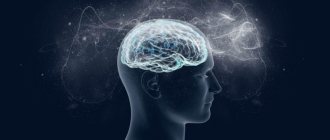What happens around a person constantly influences his sensory system, but it does not reflect all stimuli equally accurately. A person who is engrossed in a conversation with a friend, playing or working, or another activity that is important to him, may not notice what is happening around him. Only what is happening in the field of vision is clearly perceived and realized; everything else recedes into the background. Attention is
precisely what provides awareness of the process on which a person is focused.
What is attention
Attention is a perception that is selectively directed to a specific object that causes increased interest. This is a prerequisite for mastering new knowledge, skills, and performing any task. Attention, as a mental structure, gives a conscious nature to human activity, stimulates and regulates it.
To act means to be attentive to the objects of activity. Tension during any activity is always associated with tension of attention. It serves as an internal condition of mental activity, thanks to which stimuli perceived by the senses are reflected in the consciousness of the subject, and each act of purposeful activity becomes conscious.
If you answer the question about what attention is
, in simpler words, this is what determines the completeness, clarity, clarity of perception and ideas when solving daily problems.
Attention is a psychological phenomenon closely related to the body’s natural adaptation to survival in the external environment and orientation reflexes. They manifest themselves in clearer attitudes towards the clearest possible perception of phenomena that are significant to a person.
The physiology of attention is more complex. The reticular formation plays a great role in the emergence of concentration. This mesh-like formation in the brain amplifies significant external signals, passes them into the cerebral cortex and pollutes less significant ones. This helps to filter out stimuli that reach the zone of awareness.
Different human activities actualize different types of attention - involuntary, voluntary, post-voluntary.
Voluntary attention is associated with the concentration of a person’s consciousness on a stimulus object. This type of attention is actualized precisely because the object itself or its features attract, and often force, complete concentration on them. Stimuli are distinguished by suddenness, expressiveness, high intensity, novelty, contrast, highlighting against a certain background, and mobility in space. For example, an irritant may be the roar of a passing train, which makes everyone who is nearby and hears it turn their heads towards the railway, or the sound of a low-flying airplane.
Such concentration is a manifestation of the first, evolutionarily and ontogenetically the earliest form of attention.
Voluntary attention is the next, more advanced form of the mental process inherent in humans. It is consciously directed and regulated by the individual, allows you to be active, define goals, and maintain focus on achieving them.
A person needs to make an effort to stay focused. Especially when it comes to new, previously unfamiliar objects or uninteresting, unattractive objects. Voluntary attention is closely related to will, the ability to overcome external and internal obstacles.
Voluntary attention arises and develops in interaction with work and speech. Possessing it allows the individual to realize the goal, form his own intention to be attentive, and ensures continuous control over actions.
Both types of attention are closely related and can stimulate the emergence of each other. For example, when starting to perform a new, complex task, a person has to make maximum volitional efforts to concentrate on the work. At first it is difficult, but gradually the person goes deeper into the process of completing the task. Involuntary attention is activated, as the work is exciting and begins to be interesting.
This type of attention is called secondary involuntary or post-voluntary. It includes both signs of voluntary (does not require much volitional effort) and voluntary (retains purposefulness and predictability). The transition of voluntary attention to post-productive attention makes work less stressful and more effective.
The table shows the main characteristics of different types of attention.
| type of attention | conditions for occurrence | Main characteristics |
| involuntary | there is a strong, contrasting or significant stimulus that causes an emotional reaction | spontaneity, ease of occurrence, adventure |
| arbitrary | formulation of the problem | focus in accordance with the task, requires willpower, tires |
| post-voluntary | entry into activities and the resulting interest | Maintains focus and relieves stress |
Controlling the concentration of consciousness
Many people face the need for such a skill. This skill helps you fully concentrate on your work, ignoring all external stimuli and noticing only that external information that is really important.
To achieve mastery in controlling the concentration of consciousness, the ability to consciously direct its flow to a particular object, exercises for the development of visual and auditory attention and its concentration will help.
Functions of attention
Many scientists compare attention to a lens that, in clear weather, focuses the sun's rays and sets a tree on fire. Attention focuses a person’s mental powers, directs them to solving the most pressing tasks at a certain moment. It is the concentration on objects that makes it possible to see deeply, clearly, and in detail, and to successfully solve problem tasks.
In addition, attention performs other functions:
- ensures selectivity of cognitive processes, allowing a person to interact only with the most pressing and most valuable information for him at the moment;
- activates focus - helps to focus and maintain attention on a specific object, switch from one object to another;
- activates focus - allows you to select and maintain the optimal level of activity necessary to complete the task.
If a person is scattered, using his own cognitive and productive resources and not solving many problems at the same time, he has little strength left, and his work performance decreases. At the same time, consistently focusing attention first on one, then on another object allows you to achieve success.
Externally and internally focused attention
Attention can be paid either to objects of the external world, or to thoughts, feelings, memories. On this basis, externally and internally directed attention is distinguished.
If, while performing a task, memories pop up in a person’s memory that distract him from the main activity, this will be involuntary internally directed attention. Sometimes involuntary, but intense internally directed attention can cause a person to be inattentive.
Voluntary attention singles out from the entire mass of phenomena acting on analyzers only that part of it that should occupy a central place in human activity. However, this part is not always the same in volume. It is different in the same circumstances for different people and for the same person in different conditions.
Basic properties of attention
In different types of activity, a person has to use different properties of attention. Sometimes lightning-fast accuracy in the perception of movements is necessary, in other cases - long-term concentration on one object or several. Human attention
has different properties. Let's look at them in detail.
Sustainability
This property is manifested in the ability to maintain concentration on an object for a long time. Stability is characterized by the time during which a person maintains focus, and therefore is a prerequisite for bringing any task to completion. The following factors stimulate sustainability:
interest and connection of the object with the interests of the subject, his needs;
object selectivity;
personal characteristics of the subject.
The ability to maintain sustained attention also depends on the strength of nervous processes, the nature of the activity, a person’s inherent habits and ability to work.
.
Abstraction
The ability to switch attention to objects that are not related to the task at hand is the opposite of persistence. The smaller it is, the more often and easily a person is distracted from the main task, the more the productivity of his activities decreases. Distractions can be sharp and strong, sudden and dynamic stimuli that cause a range of emotional reactions.
You can overcome the tendency to get distracted by practicing completing tasks in an environment that is not entirely favorable for this.
Hesitation
Another property closely related to persistence of attention. Its manifestation is noticeable in how, in the process of performing any task, a person’s attention periodically becomes more or less intense.
Under natural conditions, vibrations are almost imperceptible, but when you need to focus on small objects, vibrations occur frequently - every 2-5 seconds and cause a person to be involuntarily distracted. In conditions where a person has to keep his attention on the edge of his capabilities, fluctuations occur even more often and quickly deplete the energy potential of the nervous system.
The main reason for fluctuations is the need to restore the performance of cortical structures and reduce their tension. Oscillations are influenced by the strength of the nervous system, conditions, content, duration and intensity of the task being performed.
Knowing about fluctuations, it is necessary to plan changes in activities, breaks in work, avoid duplication and automation of processes in order to avoid negative consequences.
Concentration
Concentration is the intensity of concentration on a specific object. The stronger the concentration, the more actively the effect of side stimuli is inhibited, the more focused and productive the activity becomes. Concentration is manifested by the fact that attention is absorbed by one object.
An indicator of the intensity of concentration is resistance to obstacles, the inability to distract attention from the subject of activity to extraneous stimuli.
Switchability
The conscious transfer of attention from one object to another is called switching. It is difficult with high concentration and is facilitated if there are connections between the content of the previous and next activities, and interest in the next activity. It makes it easier to switch attention by getting used to it, as well as understanding the importance of the next task.
The ability to switch attention makes it possible to quickly respond to changing conditions and move on to a new type of activity.
Distribution
The distribution of attention is updated when it is necessary to perform several actions simultaneously or maintain concentration on several objects. For distribution to be effective, it is necessary that the algorithm for performing at least one action be perfected to the point of automation.
Volume
The volume of attention is characterized by the number of objects that a person is able to perceive and be aware of at the same time. Normally, in 0.1 second a person can perceive from 4 to 6 objects that are not related to each other.
Involuntary
Involuntary attention is the most ancient and passive type , which arises regardless of human consciousness and is maintained without the application of volitional effort.
How do we distinguish between active and passive imagination in psychology? Find out about this from our article.
Causes and conditions of occurrence
The reason for involuntary attention lies in the external world (environment). But it also depends on the emotional and instinctive prerequisites (features) of the individual.
Any phenomenon, object or activity captivates a person because of its uniqueness, entertainingness, significance, etc.
The nature of the stimulus plays a big role : how noticeable it is in the environment and how much it stands out against the general background.
Bright colors, intense smells, excessively loud sounds and expressive tactile sensations “switch” a person’s attention to themselves.
However, there is no absolute indicator reflecting the strength of the stimulus. After all, in a dark room, the light of a flashlight will attract attention, while in a illuminated room, a switched-on flashlight may go unnoticed.
Compliance with the internal state of a person is another significant criterion. A hungry person will react to the image and smell of food much more actively than a well-fed person.
The general orientation of the personality also affects involuntary attention. A person will be directed to the perception of objects and situations related to his priority activities and interests.
Theories of attention
Many prominent scientists have studied the phenomenon of attention and developed their own theories.
One of the first and most popular was the reflex theory of attention, developed by Sechenov, Pavlov and Ukhtomsky. It connects the factors that cause the development of attention with the influence of the external environment. Stimuli act on receptors, impulses are transmitted to the human brain, cause orientation reflexes and activate adaptive reactions. They change the course of processes in the cerebral cortex and form a focus of optimal excitation (Pavlov’s formulation) or a dominant (according to Ukhtomsky). In parallel, inhibition occurs in other areas of the cortex.
Théodule Ribot associated attention with emotions and believed that they are the factor against which concentration is formed. In this state, certain physiological changes occur - blood circulation is activated, vascular and motor reactions occur. Concentration is accompanied by movement of all parts of the body, this helps maintain attention.
According to Halperin's theory, attention is a psychological act aimed at the content of an image or thought. Attention controls the content and is an integral element of orientation and research activities. At the same time, attention is not a separate process; it is always aimed at what appears as a result of other processes and contributes to the formation and improvement of mental activity.
Broadbent's theory interprets attention as a process of filtering stimuli coming from the external environment. The amount of data a person is able to focus on depends on the bandwidth of the channel through which perception occurs.
The theory of Ribot and Lange assigns an important role to movements. Scientists consider them an external manifestation and a factor in the formation of attention.
Anthony and Diana Deutsch believe that information is initially processed by working memory, and only then is it selected. Since the memory capacity is not unlimited, only part of the information remains in it. It is already assigned the status of important or unimportant.
Gonobolin, Strakhov, Dobrynin, Milerian believe that attention is directly related to activity, attention exists in it and is supported by it. According to scientists, to be attentive means to be active in relation to specific objects.
Other scientists have also studied attention. The theories of Lev Vygotsky, William James, Dmitry Uznadze and other researchers are worthy of study.
free
The main feature of voluntary attention is its connection to conscious aspirations and controllability .
This type is subject to will and labor effort.
This type is also called active and intentional.
Physiological mechanism
Basic function of voluntary attention, regulation of mental processes . The physiological mechanism is based on selective activation of parts of the cerebral cortex and their functional unification under the influence of controlled local activation.
Psychological feature
When a person needs to achieve a certain result, he develops an action plan, which includes the task of concentrating on something in order to suppress the involuntary desire to “spray” attention on more pleasant and exciting things.
A person is guided by the category “must”, meeting the requirements of the activity.
Voluntary attention is not determined by the contrast of external influences. In the process of concentration, a person ignores intense stimuli and can concentrate even in the absence of interest .
After 20 minutes of deliberate concentration, the individual becomes tired and the ability to control attention weakens.
Young children are not subject to voluntary attention , since consciousness is not yet sufficiently developed.
Managed concentration on something is developed after two years.
How do achievement motivations and failure avoidance motivations work? You will find the answer on our website.
Examples
Examples:
- The individual needs to prepare a report for the meeting. He consciously excludes the possibility of being influenced by irritants (TV, loud noises outside the window, messages in instant messengers), organizes his workplace and concentrates on the necessary documents, forcing himself by force of will to ignore pleasant thoughts about the upcoming weekend and meeting with friends.
- The girl crosses the road. At this moment, she is occupied by a beautiful showcase on the other side of the street.
But she deliberately concentrates on traffic rules and passing cars in order to avoid getting into an emergency situation. - Being in a noisy office, the employee deliberately does not listen and diverts attention from the interesting conversation of colleagues , paying attention only to the current business correspondence with the client, since it is necessary to close the deal before lunch.
- The guy set himself the task of reading two chapters from a physics textbook, after which he could go into the yard and play football with his friends. By an effort of will, he is distracted by an interesting TV show and immerses himself in reading in order to quickly cope with the task.
Features of attention
In everyday life and at work, a person can be in a state of attention, inattention and absent-mindedness. The degree of attentiveness is an innate property that can be improved throughout life depending on needs, circumstances and experience.
An attentive person has voluntary and post-voluntary attention, he has a goal, a well-developed will, he understands what he is striving for. An inattentive person cannot concentrate on a subject or understand the essence of events or things. In an absent-minded person, the degree of attention is in the middle of the continuum between attention and inattention. The actions of the absent-minded are characterized by a superficial focus and inability to concentrate on a specific object.
Attention and inattention are reflected in all areas of human activity. Attentiveness is necessary for a sensual and rational reflection of reality, arranging thoughts in a logical series. Inattention in each case is associated with the inability to focus and maintain concentration. This leads to difficulties in the cognitive sphere - the consistency, logic and evidence of judgments are disrupted, thoughts are distracted by emotional reactions.
Irina Sherbul
The concept of “attention” in psychology
The concept of “attention” in psychology means concentration on some object during mental activity.
All actions that are accompanied by close attention are always clear and relevant, thanks to which the brain will be able to perceive exactly those “stimuli” that relate to human activity at the current moment .
Consequently, “attention” can only be carried out in a certain direction of activity of a particular person. For example, if perception is auditory , then thanks to attention, you can notice the smallest sounds, and exactly those that need to be heard, distracted from third-party sounds.









